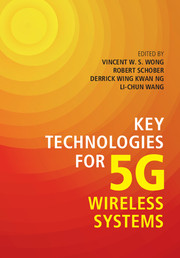Book contents
- Frontmatter
- Contents
- List of Contributors
- Preface
- 1 Overview of New Technologies for 5G Systems
- Part I Communication Network Architectures for 5G Systems
- Part II Physical Layer Communication Techniques
- 6 Non-Orthogonal Multiple Access (NOMA) for 5G Systems
- 7 Flexible Physical Layer Design
- 8 Distributed Massive MIMO in Cellular Networks
- 9 Full-Duplex Protocol Design for 5G Networks
- 10 Millimeter Wave Communications for 5G Networks
- 11 Interference Mitigation Techniques for Wireless Networks
- 12 Physical Layer Caching with Limited Backhaul in 5G Systems
- 13 Cost-Aware Cellular Networks Powered by Smart Grids and Energy Harvesting
- 14 Visible Light Communication in 5G
- Part III Network Protocols, Algorithms, and Design
- Index
- References
6 - Non-Orthogonal Multiple Access (NOMA) for 5G Systems
from Part II - Physical Layer Communication Techniques
Published online by Cambridge University Press: 28 April 2017
- Frontmatter
- Contents
- List of Contributors
- Preface
- 1 Overview of New Technologies for 5G Systems
- Part I Communication Network Architectures for 5G Systems
- Part II Physical Layer Communication Techniques
- 6 Non-Orthogonal Multiple Access (NOMA) for 5G Systems
- 7 Flexible Physical Layer Design
- 8 Distributed Massive MIMO in Cellular Networks
- 9 Full-Duplex Protocol Design for 5G Networks
- 10 Millimeter Wave Communications for 5G Networks
- 11 Interference Mitigation Techniques for Wireless Networks
- 12 Physical Layer Caching with Limited Backhaul in 5G Systems
- 13 Cost-Aware Cellular Networks Powered by Smart Grids and Energy Harvesting
- 14 Visible Light Communication in 5G
- Part III Network Protocols, Algorithms, and Design
- Index
- References
Summary
Radio access technologies for cellular communications are characterized by multipleaccess schemes whose purpose is to serve multiple users with limited bandwidth resources. Typical examples of multiple access schemes are frequency division multiple access (FDMA), time division multiple access (TDMA), code division multiple access (CDMA), and orthogonal frequency division multiple access (OFDMA). In the history of mobile communications, multiple access schemes have been widely investigated in various types of cellular networks, from the first generation (1G) to the fourth generation (4G). Specifically, the FDMA scheme was used in the 1G system, the TDMA scheme was employed in the second generation (2G) systems, CDMA was the dominant multiple access scheme in the third generation (3G) systems, and the OFDMA scheme has been widely used in 4G systems. In many conventional multiple access schemes, such as TDMA and OFDMA, different users are allocated to orthogonal resources in either the time or the frequency domain in order to alleviate interuser interference. However, the spectral efficiency of these orthogonal multiple access (OMA) schemes is low, since bandwidth resources occupied by users with poor channel conditions cannot be shared by others. As a result, these OMA schemes are not sufficient to handle the explosive growth in data traffic in the mobile Internet of the fifth generation (5G) networks. On the other hand, the chip rates of a CDMA system need to be much higher than the information data rates, which means that the use of CDMA in 5G is also potentially problematic owing to the ultra-high data rates expected in 5G systems. Consequently, in 5G networks, new, sophisticated multiple access technologies are needed to support massive connectivity for a very large number of mobile users and/or Internet of Things (IoT) devices with diverse quality-of-service (QoS) requirements [1]. Multiple access in 5G mobile networks is an emerging and challenging research topic, since it needs to provide massive connectivity, large system throughput and small latency simultaneously [2, 3]. Among the promising candidates for 5G multiple access, NOMA has received considerable attention in particular [4–7]. In contrast to conventional OMA, NOMA can accommodate user fairness via non-orthogonal resource allocation and, therefore, is also expected to increase the system throughput.
Information
- Type
- Chapter
- Information
- Key Technologies for 5G Wireless Systems , pp. 109 - 132Publisher: Cambridge University PressPrint publication year: 2017
References
Accessibility standard: Unknown
Why this information is here
This section outlines the accessibility features of this content - including support for screen readers, full keyboard navigation and high-contrast display options. This may not be relevant for you.Accessibility Information
- 11
- Cited by
